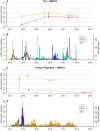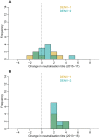Zika seroprevalence declines and neutralizing antibodies wane in adults following outbreaks in French Polynesia and Fiji
- PMID: 31987069
- PMCID: PMC6986872
- DOI: 10.7554/eLife.48460
Zika seroprevalence declines and neutralizing antibodies wane in adults following outbreaks in French Polynesia and Fiji
Abstract
It has been commonly assumed that Zika virus (ZIKV) infection confers long-term protection against reinfection, preventing ZIKV from re-emerging in previously affected areas for several years. However, the long-term immune response to ZIKV following an outbreak remains poorly documented. We compared results from eight serological surveys before and after known ZIKV outbreaks in French Polynesia and Fiji, including cross-sectional and longitudinal studies. We found evidence of a decline in seroprevalence in both countries over a two-year period following first reported ZIKV transmission. This decline was concentrated in adults, while high seroprevalence persisted in children. In the Fiji cohort, there was also a significant decline in neutralizing antibody titres against ZIKV, but not against dengue viruses that circulated during the same period.
Keywords: Zika; antibody response; dengue; epidemiology; global health; human; infectious disease; microbiology; seroprevalence.
© 2020, Henderson et al.
Conflict of interest statement
AH, MA, MK, JV, AT, TM, TP, YT, JM, JE, JW, CW, CL, VC, AK No competing interests declared
Figures













References
-
- Aubry M, Teissier A, Huart M, Merceron S, Vanhomwegen J, Roche C, Vial AL, Teururai S, Sicard S, Paulous S, Desprès P, Manuguerra JC, Mallet HP, Musso D, Deparis X, Cao-Lormeau VM. Zika virus seroprevalence, French Polynesia, 2014-2015. Emerging Infectious Diseases. 2017;23:669–672. doi: 10.3201/eid2304.161549. - DOI - PMC - PubMed
-
- Bogoch II, Brady OJ, Kraemer MUG, German M, Creatore MI, Brent S, Watts AG, Hay SI, Kulkarni MA, Brownstein JS, Khan K. Potential for Zika virus introduction and transmission in resource-limited countries in Africa and the Asia-Pacific region: a modelling study. The Lancet Infectious Diseases. 2016;16:1237–1245. doi: 10.1016/S1473-3099(16)30270-5. - DOI - PMC - PubMed
MeSH terms
Substances
Grants and funding
- Pacific funds 04917-19/07/17/Ministry for Europe and Foreign Affairs
- ZIKAlliance grant 734548/Horizon 2020 - Research and Innovation Framework Programme
- Labex IBEID grant ANR-10-LABX-62- IBEID/Investissement d'Avenir Program
- 107778/Z/15/Z/Wellcome
- 206250/Z/17/Z/Wellcome
- MR/J003999/1/MRC_/Medical Research Council/United Kingdom
- 1109035/National Health and Medical Research Council
- MR/N013638/1/MRC_/Medical Research Council/United Kingdom
- Pacific funds 02918-18/06/18/Ministry of Europe and Foreign Affairs
- 03298/MTF/REC-17/05/18/French and French Polynesia government MA'I'ORE program
- HC/372/DIE/BPT- 18/05/18/French and French Polynesia government MA'I'ORE program
- HC/245/DIE/BPT-16/05/19/French and French Polynesia government MA'I'ORE program
LinkOut - more resources
Full Text Sources
Medical

